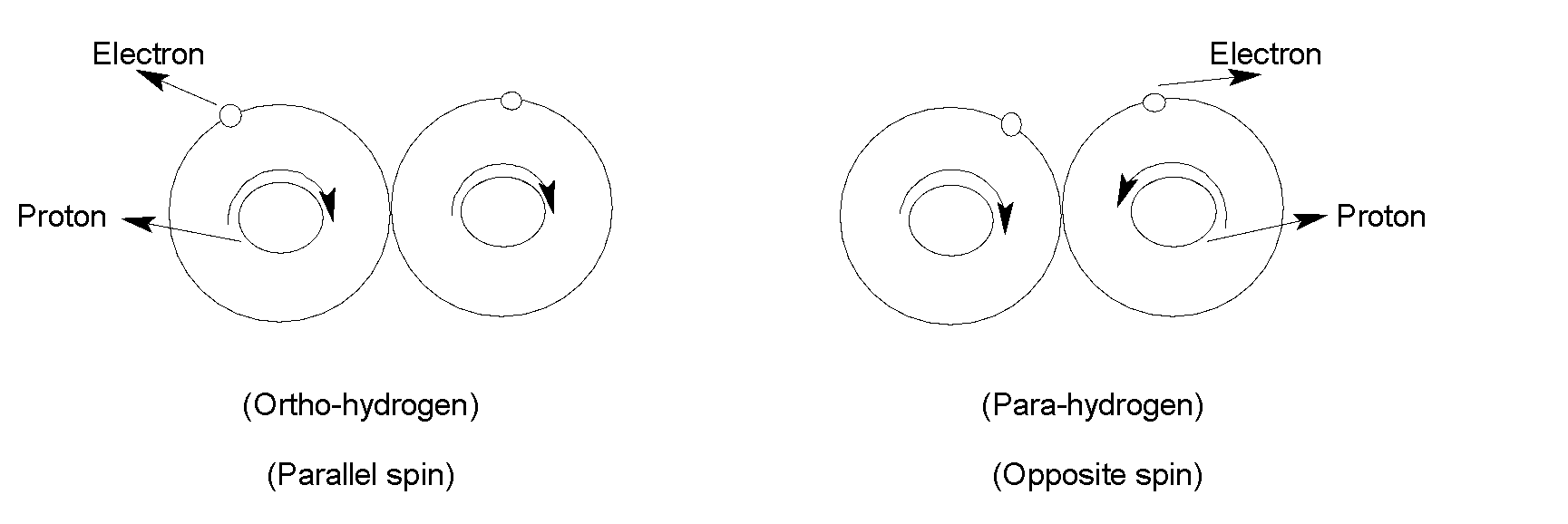
Ortho-hydrogen and para-hydrogen resembles in which of the following property
A. Thermal conductivity
B. Magnetic properties
C. Chemical properties
D. Heat capacity
Answer
222.9k+ views
Hint: Ortho- hydrogen has parallel nuclear spins whereas para- hydrogen has Anti parallel spins. Due to having two parallel spins, ortho- hydrogen has an overall nuclear spin of $1$ and para-hydrogen has an overall nuclear spin-zero. Ortho-hydrogen and parahydrogen both have different physical properties.
Complete Step by Step Answer:
The hydrogen (H) atoms have one proton inside the nucleus and one electron rotates around it. Proton also spins around its axis like an electron. If the protons of two H atoms of ${{H}_{2}}$ molecule rotate in the same direction then they are called ortho-hydrogen. When the protons of two hydrogens rotate in opposite directions then they are called para-hydrogen. Ortho and para-hydrogen are spin isomers of the molecular dihydrogen. At ${{0}^{{\mathrm O}}}K$hydrogen consists mainly of para-hydrogen and para-hydrogen is more stable than ortho-hydrogen. Ordinary hydrogen is an equilibrium mixture of both ortho and para hydrogen.

Ortho-hydrogen has an overall spin$=\left( +\frac{1}{2}+\frac{1}{2} \right)=1$
And para-hydrogen has an overall spin $=\left( +\frac{1}{2}-\frac{1}{2} \right)=0$
That is ortho hydrogen is in a triplet state as its overall nuclear spin is $1$ and para-hydrogen is in a singlet state as it has zero nuclear spins.
They have different nuclear energies due to differences in an overall nuclear spin. For this property, ortho-H and para-H have different physical properties such as thermal conductivity, heat capacity, boiling point, etc. But they have similar chemical properties because their electronic configuration is similar.
Thus, option (C) is correct.
Note: Para hydrogen can be converted into ortho-hydrogen in many different ways such as by passing an electric charge, by heating at a temperature greater than ${{800}^{{\mathrm O}}}C$, by treating with catalysis iron or platinum metal, by mixing with paramagnetic molecules such as NO, ${{O}_{2}}$ etc.
Complete Step by Step Answer:
The hydrogen (H) atoms have one proton inside the nucleus and one electron rotates around it. Proton also spins around its axis like an electron. If the protons of two H atoms of ${{H}_{2}}$ molecule rotate in the same direction then they are called ortho-hydrogen. When the protons of two hydrogens rotate in opposite directions then they are called para-hydrogen. Ortho and para-hydrogen are spin isomers of the molecular dihydrogen. At ${{0}^{{\mathrm O}}}K$hydrogen consists mainly of para-hydrogen and para-hydrogen is more stable than ortho-hydrogen. Ordinary hydrogen is an equilibrium mixture of both ortho and para hydrogen.

Ortho-hydrogen has an overall spin$=\left( +\frac{1}{2}+\frac{1}{2} \right)=1$
And para-hydrogen has an overall spin $=\left( +\frac{1}{2}-\frac{1}{2} \right)=0$
That is ortho hydrogen is in a triplet state as its overall nuclear spin is $1$ and para-hydrogen is in a singlet state as it has zero nuclear spins.
They have different nuclear energies due to differences in an overall nuclear spin. For this property, ortho-H and para-H have different physical properties such as thermal conductivity, heat capacity, boiling point, etc. But they have similar chemical properties because their electronic configuration is similar.
Thus, option (C) is correct.
Note: Para hydrogen can be converted into ortho-hydrogen in many different ways such as by passing an electric charge, by heating at a temperature greater than ${{800}^{{\mathrm O}}}C$, by treating with catalysis iron or platinum metal, by mixing with paramagnetic molecules such as NO, ${{O}_{2}}$ etc.
Recently Updated Pages
JEE General Topics in Chemistry Important Concepts and Tips

JEE Extractive Metallurgy Important Concepts and Tips for Exam Preparation

JEE Atomic Structure and Chemical Bonding important Concepts and Tips

JEE Amino Acids and Peptides Important Concepts and Tips for Exam Preparation

Electricity and Magnetism Explained: Key Concepts & Applications

JEE Energetics Important Concepts and Tips for Exam Preparation

Trending doubts
JEE Main 2026: Application Form Open, Exam Dates, Syllabus, Eligibility & Question Papers

Derivation of Equation of Trajectory Explained for Students

Hybridisation in Chemistry – Concept, Types & Applications

Understanding the Angle of Deviation in a Prism

How to Convert a Galvanometer into an Ammeter or Voltmeter

Degree of Dissociation: Meaning, Formula, Calculation & Uses

Other Pages
NCERT Solutions For Class 11 Chemistry Chapter 7 Redox Reaction

JEE Advanced Marks vs Ranks 2025: Understanding Category-wise Qualifying Marks and Previous Year Cut-offs

Hydrocarbons Class 11 Chemistry Chapter 9 CBSE Notes - 2025-26

Thermodynamics Class 11 Chemistry Chapter 5 CBSE Notes - 2025-26

NCERT Solutions ForClass 11 Chemistry Chapter Chapter 5 Thermodynamics

Equilibrium Class 11 Chemistry Chapter 6 CBSE Notes - 2025-26




